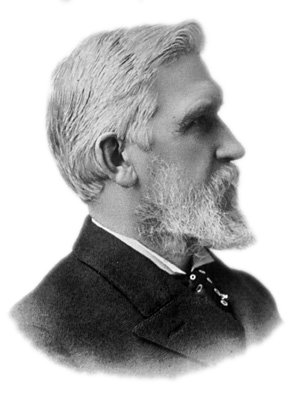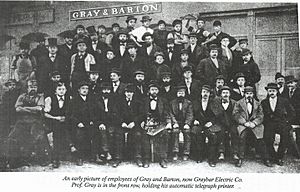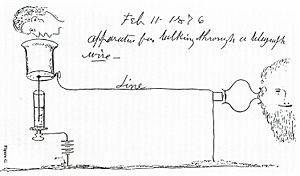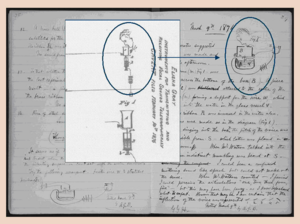Elisha Gray facts for kids
Quick facts for kids
Elisha Gray
|
|
|---|---|
 |
|
| Born | August 2, 1835 Barnesville, Ohio, U.S.
|
| Died | January 21, 1901 (aged 65) Newtonville, Massachusetts, U.S.
|
| Occupation | Engineer/Inventor |
| Awards | Elliott Cresson Medal (1897) |
| Signature | |
 |
|
Elisha Gray (born August 2, 1835 – died January 21, 1901) was an American electrical engineer and inventor. He helped start the Western Electric Manufacturing Company. Gray is famous for developing an early version of the telephone in 1876.
Some people believe Gray should be seen as the true inventor of the telephone. They say that Alexander Graham Bell might have used Gray's idea for a "liquid transmitter." Even though Gray had been experimenting with liquid transmitters for a long time, Bell's telephone patent was supported by many court decisions.
Gray is also known as a pioneer of the modern music synthesizer. He received over 70 patents for his inventions. He was also one of the people who founded Graybar, a company that still exists today.
Contents
Early Life and Inventions
Elisha Gray was born in Barnesville, Ohio. His family were Quakers, and he grew up on a farm. He went to Oberlin College and experimented with electrical devices. Even though he didn't graduate, he taught about electricity and science there. He also built equipment for the college's science labs.
In 1862, Gray married Delia Minerva Shepard while he was at Oberlin.
In 1865, Gray invented a special telegraph device. It could automatically adjust itself to work better with different telegraph lines. In 1867, he received his first patent for this invention. He would go on to get more than seventy patents in his lifetime.
In 1869, Elisha Gray and his partner Enos M. Barton started Gray & Barton Co. in Cleveland, Ohio. Their company supplied telegraph equipment to the large Western Union Telegraph Company. Later, the part of the business that dealt with electrical distribution became a separate company called Graybar Electric Company, Inc.
In 1870, a superintendent from Western Union, General Anson Stager, helped Gray & Barton Co. get money. Stager became an active partner. The company moved to Chicago, near Highland Park. Gray later left his job as chief engineer to focus on inventing new things for the telegraph industry. A dentist named Dr. Samuel S. White helped pay for Gray's inventions and patents. Dr. White wanted Gray to focus on the acoustic telegraph, which seemed more profitable than the telephone at the time.
In 1870, Gray also created a special indicator for hotels and elevators. He also made a "microphone printer" that had a typewriter keyboard and printed messages on paper tape.
In 1871, the Great Chicago Fire destroyed much of the city, including its telegraph system. Gray & Barton was hired to rebuild it. In 1872, Western Union bought one-third of Gray and Barton Co. and changed its name to Western Electric Manufacturing Company of Chicago. Gray continued to invent for Western Electric.
In 1874, Gray retired to work on his own research and inventions. He applied for a patent for a "harmonic telegraph." This device could send multiple musical tones, with each tone controlled by a separate telegraph key. Gray showed this invention to people in New York and Washington, D.C.
On December 29, 1874, Gray gave the first public demonstration of his musical telegraph in Highland Park, Illinois. He sent "familiar melodies through telegraph wire." This was one of the first electric musical instruments. It used vibrating circuits to create single notes, played with a two-octave piano keyboard. Gray also built a simple loudspeaker to make the musical tones louder.
On July 27, 1875, Gray received a patent for his "Electric Telegraph for Transmitting Musical Tones." He continued his experiments, and on February 15, 1876, he received another patent for an electro-harmonic telegraph with a piano keyboard.
The Telephone Controversy
Elisha Gray's financial supporter, Samuel White, did not want him to work on the telephone. Because of this, Gray did not talk about his invention for sending voice sounds until February 11, 1876. The only proof of his idea from that day is a drawing he made. Gray asked his patent lawyer to prepare a "caveat" for the U.S. Patent Office. A caveat was like a temporary patent application. It included drawings and a description but didn't ask for a full review yet.
On Monday morning, February 14, 1876, Gray signed his caveat. It described a telephone that used a liquid transmitter. His lawyer then submitted it to the U.S. Patent Office. On the very same morning, a lawyer for Alexander Graham Bell also submitted Bell's patent application. It is still debated which application arrived first. Gray believed his caveat arrived a few hours before Bell's application.
Bell's lawyers had been waiting for months to file his patent application. They were told not to file it in the USA until it was filed in Britain first. This was because, at the time, Britain only gave patents for new discoveries not patented anywhere else.
According to some accounts, Bell's lawyer learned about Gray's liquid transmitter idea during the weekend before the filings. Bell's lawyer then supposedly added seven sentences describing the liquid transmitter to Bell's application. Bell's lawyer then quickly delivered the application to the patent office. This happened a few hours after Gray's caveat was delivered. Bell was in Boston and didn't know his application had been filed.
Five days later, on February 19, Zenas Fisk Wilber, the patent examiner for both Bell's application and Gray's caveat, noticed a problem. Bell's application claimed the same "variable resistance" feature that was in Gray's caveat. Wilber stopped Bell's application for 90 days. This gave Gray time to submit his own full patent application.
Bell's lawyer told Bell to come to Washington, D.C. When Bell arrived, he visited his lawyers and then examiner Wilber. Wilber told Bell that Gray's caveat showed a liquid transmitter. He asked Bell for proof that Bell had invented this idea first. Bell pointed to an earlier application where he used mercury in a circuit breaker. The examiner accepted this, even though mercury wouldn't work in a telephone transmitter.
On February 29, Bell's lawyer changed Bell's claims to make them different from Gray's caveat. On March 3, Wilber approved Bell's application. On March 7, 1876, Bell's patent (number 174,465) was published by the U.S. Patent Office.
Bell went back to Boston and continued his work. On March 9, he drew a diagram in his notebook of a water transmitter. It looked very similar to the one in Gray's caveat. Bell and his assistant, Watson, built and tested a liquid transmitter on March 10. They successfully sent clear speech, with Bell saying, "Mr. Watson – come here – I want to see you." Bell's notebooks became public in 1976.
Some people have accused Bell of stealing the telephone idea from Gray. This is because Bell's liquid transmitter design looked like Gray's. However, documents show that Bell had been using liquid transmitters in his experiments for three years. In April 1875, ten months before the supposed theft, Bell received a patent for a simple fax machine. This patent drawing also included liquid transmitters.
After March 1876, Bell and Watson focused on making the electromagnetic telephone better. They never used Gray's liquid transmitter in public shows or for selling telephones.
Even though Gray had given up on his caveat, he applied for a patent for the same invention in late 1877. This led to another conflict with Bell's patents. The Patent Office decided that Gray was the first to think of the variable resistance idea. But because he didn't finish his invention until others had shown it worked, he lost his right to claim it. Gray still challenged Bell's patent. After two years of legal battles, Bell was given the rights to the invention. This is why Bell is known as the inventor of the telephone.
Some historians have pointed out that examiner Wilber's later statements about showing Gray's caveat to Bell were made while working for a company trying to challenge Bell's patents.
Other Inventions
In 1887, Gray invented the telautograph. This device could send handwriting over telegraph systems. Gray received several patents for these early fax machines. The Gray National Telautograph Company started in 1888 and continued for many years. It was later bought by Xerox.
Gray's telautograph machines were used by banks to sign documents from far away. The military used them to send written commands during gun tests. This was helpful because the loud noise from the guns made it hard to hear spoken orders on the telephone. Train stations also used these machines for schedule changes.
Gray showed his telautograph invention at the 1893 Columbian Exposition in Chicago. He sold his share in the telautograph company soon after. Gray was also the chairman of the International Congress of Electricians at this big exhibition.
Gray also thought of a basic closed-circuit television system. He called it the "telephone." Pictures would be focused onto special cells. Signals from these cells would then be sent to a distant place using separate wires. At the receiving end, each wire would open or close a shutter to recreate the image.
In 1899, Gray moved to Boston and continued inventing. One of his projects was to create an underwater signaling device to send messages to ships. One such device was tested on December 31, 1900. Three weeks later, on January 21, 1901, Gray died from a heart attack. After his death, officials gave his underwater signaling invention to Oberlin College. A few years later, he was recognized as the inventor of this device.
It's important to know that the Gray code, a special way of counting in computers, is not named after Elisha Gray. It's named after a different electrical researcher from the 20th century, Frank Gray.
Images for kids
See also
 In Spanish: Elisha Gray para niños
In Spanish: Elisha Gray para niños
- Invention of the telephone
- Timeline of the telephone
- The Telephone Cases
- Water microphone







